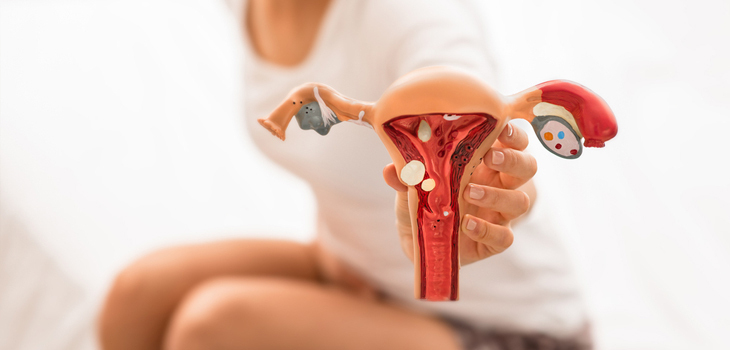
Endometriosis is derived from the term “endometrium,” which refers to the uterine tissue. Endometriosis is characterized by the presence of endometrial-like tissue beyond the uterus in patients. Endometriosis most commonly affects the fallopian tubes, ovaries, and tissue lining the pelvis. Endometrial tissue rarely spreads outside of the pelvic region, but it is not impossible. Endometrial implants are areas of endometrial tissue that grow outside of the uterus.
Endometrial tissue accumulates and is shed during a woman’s routine menstrual periods if she hasn’t become pregnant. Women with endometriosis possess tissue that looks and behaves the same as endometrial tissue beyond the uterus, usually on some other reproductive organs within the pelvis or perhaps in the abdominal cavity. Each month, this misplaced tissue in the pelvis reacts to the hormonal fluctuations of the menstrual period by building up and breaking down in the same way that the endometrium does. This means that the tissue will expand, thicken, and disintegrate. Over time, the degraded tissue has nowhere else to go and thus becomes trapped in the pelvis.
This trapped tissue in the pelvis can lead to:
- Itchiness
- Formation of scars
- Adhesions are formed when tissue binds the pelvic organs together.
- Menstrual cramps are excruciating pains that occur during the menstrual cycle.
- Fertility issues
When the ovary is implicated, blood could become embedded in normal ovarian tissue, resulting in a “blood blister” enveloped by a fibrous cyst known as an endometrioma.
Causes of Endometriosis
Even though the actual cause of endometriosis is unknown, the following theories have been proposed:
Retrograde Menstruation
Menstrual blood comprising endometrial cells goes straight back through fallopian tubes and then into the pelvic cavity, rather than out of the body, during retrograde menstruation. These endometrial cells adhere here to pelvic walls and pelvic organ surfaces, where they grow, condense and bleed throughout the menstrual cycle.
Peritoneal Cell Transformation
Experts through “induction theory” propose that hormones or immune factors stimulate the cells that make up the inner side of the abdomen, peritoneal cells to transform into endometrial-like cells.
Embryonic Cell Transformation
During puberty, hormones such as estrogen can transform embryonic cells (cells in their initial phases of development) into endometrial-like cell implants.
Surgical Scar Implantation
Endometrial cells may get bonded to a surgical incision after a procedure such as a C-section or a hysterectomy.
Endometrial Cell Transport
Endometrial cells may be transported to other parts of the body via the blood vessels of the tissue fluid (lymphatic) system.
Immune System Dysfunction
An issue with the immune system may prevent the body from recognizing and destroying endometrial-like tissue that develops outside the uterus.

Where Can Endometriosis Occur?
Endometriosis is most commonly found in the following areas:
- The ovaries
- The fallopian tubes
- Ligaments that hold the uterus together (uterosacral ligaments)
- The posterior cul-de-sac, also known as the space between both the uterus and the rectum
- The anterior cul-de-sac, also known as the space between both the uterus and the bladder
- The uterus’s external surface
- The inside lining of the pelvic area
Endometrial tissue is occasionally discovered in other places, such as:
- The digestive tract
- Rectum
- The urinary bladder
- The vaginal canal
- Cervical artery
- The vulva’s
- Scars from abdominal surgery
Risk Factors
Women are more likely to develop endometriosis if they have any of the following risk factors:
- Never having children
- Beginning their period at a young age
- Experiencing menopause at a later age
- Menstrual cycles which are less than 27 days, for example, are considered short.
- Menstrual cycles that can last for more than seven days
- Higher estrogen levels in their body or a substantial amount of estrogen produced by the body
- Body mass index is low.
- Family history of Endometriosis
- Any medical problem that prevents blood from leaving the body during menstruation.
- Reproductive system disorders
- Endometriosis usually appears several years after menstruation begins (menarche). Endometriosis symptoms may improve temporarily during pregnancy and disappear completely during menopause if you are not taking estrogen.
Symptoms
The following are typical symptoms of endometriosis, but each woman will experience symptoms differently, and some will not experience any symptoms at all. Endometriosis symptoms can include:
- Pain, particularly severe menstrual cramps mostly in the abdomen or lower back portion of the body
- Excessive pain caused Intercourse
- Menstrual flow that is abnormally heavy or excessive
- Infertility
- Painful urination during menstruation
- Painful bowel motion during menstruation
- Other gastrointestinal issues, such as diarrhea, constipation, and/or nausea
It is crucial to highlight that the amount of pain a woman feels is not always related to the severity of the condition. Some women who suffer from a severe form of endometriosis may have no pain, whereas some with a fairly mild illness may have intense pain or other symptoms.

Endometriosis Stages
The stage of the disease is determined by a variety of factors. Endometrial implants’ position, number, scale, and depth are examples of such factors. Endometriosis is categorized into 4 stages or types. It is briefly described as follows:
Stage 1: Minimal
When there are minor lesions or wounds on the ovaries, as well as shallow endometrial implants, this is referred to as minimal endometriosis. Swelling in and around the pelvic area is also possible.
Stage 2: Mild
Mild endometriosis is made up of small lesions as well as shallow implants mostly on ovaries and pelvic lining.
Stage 3: Moderate
Moderate endometriosis is characterized by numerous deep implants on the ovaries and pelvic lining. There could also be additional lesions.
Stage 4: Severe
Endometriosis at its most severe stage involves numerous deep implants on the pelvic lining and ovaries. There could be the development of lesions on the fallopian tubes and bowels as well. Growth of cysts on one or both of the ovaries is also possible.
Diagnosis
For many women, merely being diagnosed with endometriosis is enough to provide relief. To begin the diagnosis process, a gynecologist or other health care provider evaluates a patient’s medical history and performs a medical assessment, including a pelvic exam. Endometriosis can only be diagnosed with certainty if the doctor performs a laparoscopy and obtains biopsies or any suspicious tissue, which is then examined under a microscope to confirm the diagnosis. Laparoscopy is a minor surgical procedure that involves inserting a laparoscope, which is a thin tube with a camera at the end, through a small incision into the abdomen. Laparoscopy is also used to determine the location, scope, and size of endometrial growths.
Other tests that may be used to diagnose endometriosis include:
Ultrasound
A diagnostic imaging method that creates a detailed image of the organs using high-frequency sound waves.
CT scan
A noninvasive diagnostic imaging procedure that employs a mixture of X-rays and computer technology to generate horizontal, or axial, images — commonly referred to as slices — of the body in order to detect any abnormalities that may not be visible on a standard X-ray.
MRI examination
A non-invasive procedure that generates a two-dimensional image of the internal organ or structure.
Treatment Alternatives
The health care provider will determine the best treatment for endometriosis based on the following factors:
- The overall health as well as the medical history
- Current signs and symptoms
- The disease’s scope
- One’s ability to tolerate specific medications, procedures, or therapies
- Expectations for the disease’s progression
- One’s point of view or preference
- One’s desire to become pregnant
If the symptoms are mild, most health care providers believe that no more treatment, apart from pain medication, is required.
In general, endometriosis treatment may include “Waiting with bated breath” to see how the disease progress. Here are a few of the treatments usually provided:
Pain Medication
Nonsteroidal anti-inflammatory drugs (NSAIDs) such as ibuprofen or any other over-the-counter pain relievers are used to treat pain.
Hormone Therapy
This treatment procedure involves prescribing:
- Oral contraceptives containing estrogen and progestin (a compound formed by progesterone) hormones are used to help stop ovulation and lessen menstrual flow.
- Progestins
- Agonist of gonadotropin-releasing hormone, which causes ovarian hormone production to cease, resulting in “medical menopause.”
- Danazol is a synthetic testosterone derivative (a male hormone)
Endometriosis can also be treated surgically using the following techniques:
Laparoscopy (also used to accurately identify Endometriosis)
A minor surgical technique where a laparoscope, a slender tube with a lens as well as a light, is introduced into an incision in the abdominal wall; the doctor can often remove endometrial growths using the laparoscope to view the insides of the pelvic area.
Laparotomy
A more invasive surgery that removes as much of displaced endometrium as feasible while preserving healthy tissue.
Hysterectomy
A surgical procedure that involves the removal of the uterus and possibly the ovaries.
Conclusion
It is critical to thoroughly talk about any or all of these treatments with your healthcare professional, as some may interfere with the effectiveness of others. To know more book an appointment at Dr. Mehta’s Hospitals.
